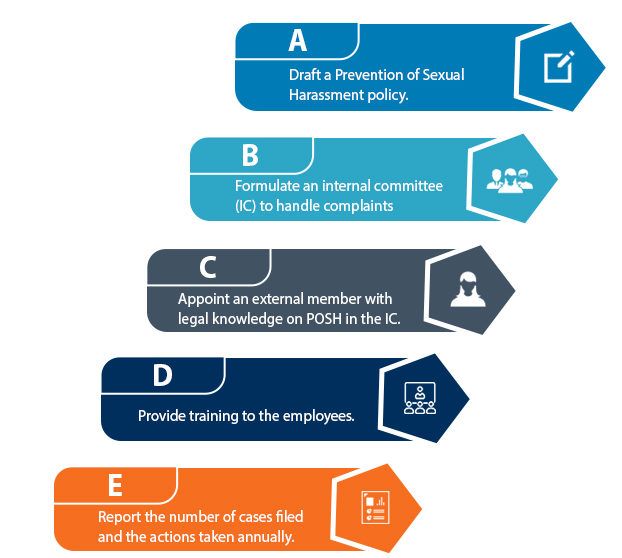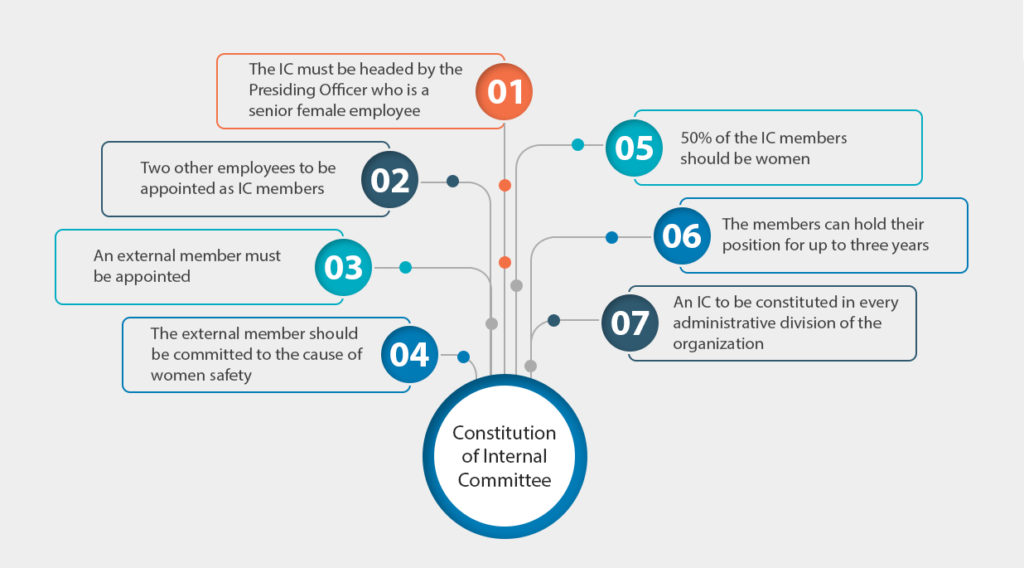Did you know?

Thanks to the #MeToo movement, the menace of sexual harassment at workplace has gained spotlight and has prompted many to come out with their experience of sexual harassment.
Sexual Harassment of Women at Workplace (Prevention, Prohibition and Redressal) Act / POSH Act enacted in 2013 by the Government of India is a major step towards preventing any form of misconduct towards women based on gender in the workplace.
Prevention of Sexual Harassment Act (POSH Act) clearly lays down the various steps an organization should take to create a safe workplace for women. Unfortunately, we see many organizations struggling to fully implement the measures prescribed by the Act. This may probably be because of the lack of awareness about the legalities and procedures involved to stay compliant with the Act.
Like many think, implementing POSH Act’s guidelines for the workplace is not complex. Let’s see how.
MANDATORY STEPS TOWARDS POSH COMPLIANCE

POST Act mandates that an organization should implement the following steps to stay compliant:
- Step 1: Draft an organizational policy on Prevention of sexual harassment (POSH Policy).
- Step 2: Change employment contract to reflect organization’s POSH policy.
- Step 3: Constitute an Internal Committee (IC) to handle complaints regarding sexual harassment.
- Step 4: Create awareness among employees on their rights and responsibilities towards creating a safe workplace.
- Step 5: Submit Annual Report on POSH Compliance.
Let’s have a look at each obligation in detail.
Step 1: POSH Policy
The organization is expected to draft a POSH policy that details the processes and steps it would take to implement POSH at the workplace.
If you are looking to draft a POSH Policy with branding for your organization, check our easy-to-use bot-based tool that can help you draft a POSH policy in just 5 minutes which is included in the Internal Committee subscription.
So, what should the POSH policy contain?
Typically, the POSH policy should cover the following:
- The objective and purpose of the POSH policy must be stated very clearly.
- The coverage of the policy i.e. ‘who does the POSH Policy apply to’ and ‘where does it apply to’ should be clearly explained. Example: Employees, contractors, interns, consultants, office premises, office transport, parking lot, team outing, conferences etc. Though the POSH Act offers protection only for female employees, the organization can go the extra mile and make their POSH Policy gender neutral.
- The definition of what constitutes sexual harassment must be detailed in unambiguous terms. This is very important as lack of clarity can create issues later.
- Responsibilities of the employees should be explained. Example: Responsibilities of an employee as an aggrieved person, offending person, supervisor, witness etc. must be detailed. This can be done in the form of simple “dos and don’ts”.
- Information about the constitution of the Internal Committee (IC) and the details of the Internal Committee members must be provided in the policy.
- The procedure to file complaints must be explained in a simple to understand manner.
- The organization’s complaints handling procedure must be covered in the organizational POSH policy.
- The organization’s procedure on receipt of complaints and its investigation process with timelines must be detailed.
- The procedure to communicate the findings of the investigation should be mentioned.
- The details of disciplinary measures, penalties and fines must be indicated in the policy. The POSH policy can also include the legal consequences of sexual harassment.
- Appeal procedures must be detailed in the policy.
- Organization’s compensation procedures for the complainant must be mentioned.
- Privacy clause must be included to ensure confidentiality about the complainant, respondent, witnesses, the details of the complaint and the investigation process.
Click Here to see the POSH Policy drafting tool in action.
Step 2: Employment Contract that reflects POSH policy
It is important that the offer letter and employment contract state the organization’s commitment to ensure safe workplace and the disciplinary cum legal actions an employee would face when they violate the POSH policy of the organization.
Step 3: Internal Committee (IC)
Purpose of IC
Internal Committee is a judicial body formulated in an organization that has 10 or more employees. The Employer must pass an order in writing to constitute an IC. For example, if the organization is a private limited company, the order in writing for the constitution of an IC should be passed as a Board Resolution. The IC is responsible to handle and redress complaints on sexual harassment.

Formulation of Internal Committee
The IC should have 3 types of members. They are:
- Presiding Officer: This member will be the chairperson of the Internal Committee and should be a senior-level female employee. This is to make the IC more approachable to women complainants. Know more about the Presiding Officer.
- Employee Members: The IC should also include two or more members from the employees, preferably individuals who have decent legal knowledge, experience in social work, or committed to the cause of women.
- External Member: The IC should include an external member who is not connected to the organization in any manner except as an external member. The person should be familiar with issues relating to sexual harassment, or from a non-governmental organization or association committed to the cause of women. The idea of an external member can be a little bit confusing. Let’s see more about it.
What is the role of an External Member?
In principle, external member ensures that the activities of the IC are unbiased and uninfluenced, thus providing neutrality and transparency in the complaints handling and inquiry process.
Here is a brief list of some of the roles that an External Member in the Internal Committee may perform:
- Active involvement in formulating and reviewing the organization’s POSH policy.
- Impartial role in handling and supervision of complaints related to Sexual Harassment.
- Professional advice to the organization on implementation of POSH policy (whenever required).
- Participating in regular meetings with the IC members to ensure complete and proper implementation of the POSH policy.
- Drafting the Minutes of Meeting for IC meetings (if required)
- Contribution to Annual Report preparation.
As the External Member have a significant role in preventing sexual harassment at work and ensuring that every sexual harassment complaint has been effectively redressed, it is imperative that organizations set a high standard in selecting the External Member for the Internal Committee. Check out eLearnPOSH’s External Member Directory from which organizations can search for External Members and select a suitable External Member based on several criteria like experience, languages known and location.
Can the External Member charge a fee for their services?
The External Member is entitled for an allowance paid by the employer and also allowed to claim for the reimbursement of the travel costs. Additionally, a person can act as an External Member for more than one organization.
If you wish to provide service as an External Member (EM), you can register in our EM Directory and join the community.
Should all IC members be women?
It is mandatory that one-half of the IC members are women and the presiding officer should be a woman.
Is there a term for the IC members?
An IC member can hold his/her position for a maximum of three years. However, an IC member can also be removed or disqualified from his/her position before they finish the term. We will discuss the disqualification of the IC members later in the blog.
Responsibilities of IC
By passing an order to form an IC, the organization authorizes the IC to do the following:
- To draft the Sexual Harassment Policy for the organization
- To work towards providing a safe and respectful working environment
- Organize training and awareness programs (classroom / eLearning) at regular intervals
- To conduct meetings:
- When there is a complaint received in writing from any of the women employees,
- To settle grievances and
- To make sure there is appropriate compensation for any case of misconduct and sexual harassment
Disqualification of an IC Member
According to the POSH law, an IC member will be disqualified when:
- The person discloses matters that are deemed confidential by the POSH law like information regarding the harassment complaints, identity of the complainant, the respondent or witnesses, details of inquiry proceedings and recommendations of the IC, or action taken by the employer.
- The person is convicted, or an inquiry is pending against the person, for any offense under any law.
- The person is going through disciplinary proceedings for any of his/her actions at the workplace.
- The person has abused their position as an IC member in any form.
When any of the four criteria applies, the IC member will be disqualified and should therefore step down. The organization has now the obligation to appoint a suitable person as a replacement.
Legal implications when IC is not formed
The POSH Act is very serious about constitution of the IC and an organization can get into trouble if IC is not constituted properly.
Here’s a brief look at the legal implications if the IC is not formed according to the mandates of the law:
- If constituted incorrectly, the Courts in India can dissolve the Internal Committee and direct the organization to reconstitute the Internal Committee in strict compliance with the POSH Act.
- The complaints will have to go through a fresh inquiry by the new Internal Committee.
- If there is an element of bias in constitution or inquiry, then the complaint may be assigned to a competent authority to conduct the inquiry, such as the Local Complaints Committee.
The legal consequences if an IC is not formed are:
- Penalty extending up to Rs. 50,000.
- Double penalty in cases of repeat offences.
- Cancellation or non-renewal of business license.
Enablement of IC members
A major challenge faced by organizations is how effectively the IC handles complaints related to sexual harassment at workplace. A few years ago, an employee of an MNC who was accused of sexual harassment, committed suicide and this led to serious consequences for the IC members and the organization. This incident shows that a poorly trained IC can do more harm than good. Surveys conducted on this subject also reveal that many internal committee members are not adequately trained to effectively handle sexual harassment complaints. Therefore, it is important that the IC members are trained well.
Step 4: Creating Employee Awareness
POSH law mandates that an organization should take all necessary steps to create awareness among its employees about prevention of sexual harassment and the POSH law.
Creating adequate awareness among the employees is one of the biggest challenges organizations face. For example, not many employees have clarity on what is considered inappropriate behavior and what constitutes sexual harassment. In many cases, there is a thin line between what is acceptable conduct and what is not. The sensitivity of the topic and personal perspectives and attitudes of employees can make the whole thing complex. Nevertheless, awareness sessions are very important to sensitize the employees about POSH.
This blog has a list of pointers that every organization must consider when choosing a POSH Awareness program for employees.
Different ways to create awareness among employees:
There are many ways employers can create awareness among the employees. To create awareness on sexual harassment prevention, organizations can use:
- Classroom sessions
- eLearning courses
- Awareness programs like “Sexual Harassment Awareness week / month”
- Standees on POSH placed at areas like cafeteria where employees gather in big numbers.
- Posters and banners on POSH sent through emails to all employees.
- Short and engaging video on POSH launched in the HR portal or the company website.
These methods will not only create awareness among the employees but will also instil confidence in them to speak up if they witness any inappropriate behaviour. This is very crucial for the success of POSH implementation in an organization.
Criteria to Identify the Right POSH Training:
Training the employees on POSH involves investment of resources like money and time. So, it is crucial to have right course for the organization. You can employ four criteria to identify the right POSH course:
- Legally accurate course: The main objective of the POSH training is to sensitize the employees about sexual harassment and the legalities associated with it. Since there is a legal angle involved, it is very important that the training accurately reflects the principles and directions enunciated by the Sexual Harassment of Women at Workplace Act. It can be tricky to identify a training provider who can ensure legal accuracy of the content. The search for a legally accurate content can be simplified by engaging providers who are empanelled by the Ministry of Women and Child Development (WCD), Government of India.
- Engaging and interactive course: Since the topic of sexual harassment is very sensitive and the legalities involved can make it very complex, it is very important that the courses are engaging and interactive. This will help the learners in their comprehension and knowledge retention. The course can be made engaging and interactive through real-life based scenarios, examples, activities and knowledge check.
- Role-based courses: As the saying goes, “One size doesn’t fit all”. The expectations towards POSH compliance at workplace vary depending on the role the employees perform in the organization. For example, the responsibilities of people managers will be different to that of individual contributors and IC members. This makes it very important that the training caters to the exact role played by the employee in the organization.
- Industry-specific course: Most times, the courses delivered are very generic. For example, the generic scenarios or examples used in the course may not be relevant to your business vertical or the industry. This may lead to a disconnect between the content and the learners, and thus affecting the effectiveness of the POSH training. You can opt for customization of the courses to meet the requirements for your organization.
Creating POSH Awareness among employees:
Organizations can create awareness among employees in different ways. Awareness sessions are very important to sensitize the employees about POSH. The common methods employed to create employee awareness on POSH are classroom sessions and online training (eLearning courses).
Should your organization consider classroom training or online training?

Here are few questions to help you decide.
- Does your organization have a distributed workforce? Do your employees telecommute?
- Do you have lot of employee churn in your organization?
- How many awareness sessions do you conduct in a year for your employees? Do the repeat sessions cost you a lot?
- Do you have a need to conduct awareness training in regional languages?
- Do you conduct separate enablement sessions for IC members?
- Do you want to simplify compliance tracking and reporting?
If the answer is yes for most of the questions, online training would be a better choice for your organization.
Why should you choose online training for POSH awareness?
- Cost-Effective: The flexible and scalable model provided by online training saves significant training costs for your organization because you just have to invest once and can use the courses repeatedly to enable your employees.
- Distributed workforce: A person who works remotely can complete the online training at his own time and pace without any difficulty.
- Employee churn: Whenever new employees join your organization (even if it is a single employee), they can be trained through online programs without any delay.
- Repeated sessions: Online training courses are one-time investments. However large the number of employees may be, the employees can access the online training any number of times with no additional cost.
- Languages: If the employees in the organization must be trained in regional languages, online training is a viable option. (eLearnPOSH offers POSH courses in Hindi, Marathi, Bengali, Kannada, Telugu, Malayalam and Tamil. For a free demo, contact us).
- IC enablement sessions and refreshers: Handling sexual harassment related complaints come with its own challenges and online training makes it easier to train IC. Whenever there is an addition or replacement of IC members, online training can make the task simpler.
- Tracking and Reporting: Tracking and reporting of employee compliance become simpler and easier when online trainings are used.
Apart from the points above, since sexual harassment is a sensitive topic, the employees would feel more comfortable learning the topic online, because it allows them the privacy they need.
Click Here to explore the POSH Awareness Training for employees.
Step 5: Annual Report Filing
As per section 21 of the POSH Act 2013, it is mandatory for the Internal Committee to file an annual report with the District Officer. The act states “The Internal Committee or the Local Committee, as the case may be, shall in each calendar year prepare, in such form and at such time as may be prescribed, an annual report and submit the same to the employer and the District Officer.”
How to Draft a POSH Annual Report?
The final step towards POSH compliance is report filing.
Section 22 of the POSH Act 2013 states that “The employer shall include in its report the number of cases filed, if any, and their disposal under this Act in the annual report of his organization or where no such report is required to be prepared, intimate such number of cases, if any, to the District Officer.”
Apart from the organization details like name, registration number and address, the annual report will contain the following:
- Total number of sexual harassment complaints received.
- Total number of sexual harassment complaints actioned and completed.
- Total number of sexual harassment complaints under investigation for more than 90 days.
- Total number of employees in the organization and the number of employees trained on POSH awareness.
- Nature of the action taken by the Organization or District Officer.
Refer this blog before you file the Annual Report for the calendar year to ensure that you are at the right side of the law.
Check our latest Tools and Resources for IC members built to ease and automate the compliance process.
“If you think compliance is expensive, try non-compliance.” – General Paul McNulty, Former US Deputy Attorney.
POSH Compliance is not a choice, rather a duty of every law-abiding organization. Let’s join hands to work towards creating a safe and respectful workplace environment!
For more updates on POSH, kindly follow our LinkedIn page.
To book a personalized demo call directly with the Subject Matter Expert, you can write to sales@succeedtech.com





Leave a Reply